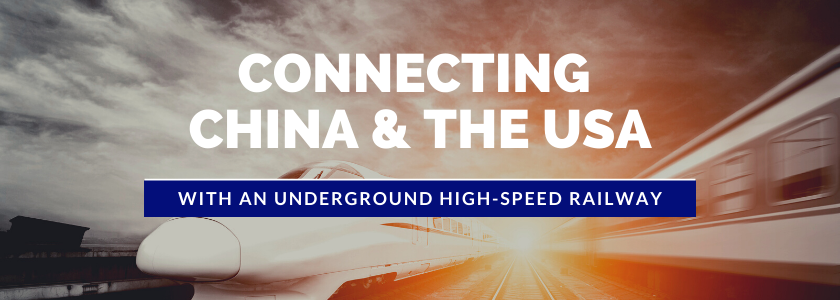Can An Underwater High-Speed Rail Work?
The world of high-speed rail has seen significant advancements over the years and now it’s promising even more. Based on discussions from seven years ago, we could see a high-speed rail line spanning 8,077 miles (13,000 km) from China to America.
Ambitious High-Speed Rail Line
In 2014, there was an ambitious plan to build a high-speed rail line that would run from the northeast of Beijing through Siberia, and then travel 124 miles (200 km) underwater crossing the Bering Strait into Alaska. At the time, numerous news outlets reported the ambitious project highlighting just how much it would bolster trade between China, Russia, Canada, and the U.S.
The report from China stated they were “in discussions” over the $200 billion rail project but not much has been said or done since then. Now, some reports have emerged that could shed some light as to why the project seems to be on hold. According to the South China Morning Post, many criticised the initial proposed budget of $200 billion which could be the starting point.
Challenges Of The China-Russia-Canada-America High-Speed Rail Line
In addition to the significant investment, detractors also pointed out that flights and cargo ships are cheaper for trade, and that the infrastructure is already in place. Another factor to consider is engineering and logistics. Aside from the challenges across the Siberian landscape, the underwater tunnel would be an unprecedented undertaking in itself.
Whilst there are existing underwater tunnels connecting the UK and France, and the Seikan Tunnel between Hokkaido and Honshu in Japan, they are only 30 miles (+- 50 km) long. For this to work, the “China-Russia-Canada-America line” high-speed rail would need to be at least four times bigger.
Then there is the issue around US-China trade relations as it needs to be near-perfect before anything can happen. Even with all of these obstacles, the project is not over yet as there are some indications it could eventually go ahead.
Is An Underwater Rail Line Feasible?
In the original report from 2014, China was already in talks with Russia as there were plans to build a rail line under the Bering Strait for several years. Engineers from both countries agreed that such a project would be possible with today’s technologies.
China had already approved the world’s first underwater bullet train in 2018 which showed that high-speed rail technology was indeed feasible underwater. The proposed bullet train will extend 47.8 miles (77 km) from Ningbo, a port city near Shanghai, to the archipelago islands of Zhousan off the East coast. A 10-mile section of that route will be underwater spanning approximately 16.2 kilometres.
Whilst the Ningbo-Zhousan line is much smaller than the Channel Tunnel, it will be a proving ground for underwater maglev rail lines. If the Ningbo-Zhousan line is successful, China will likely turn to larger projects such as the “China-Russia-Canada-America line”.
Sustainability Of Rail Transport To Boost Big Infrastructure Projects
Compared to air and road freight, rail transport has a much greener infrastructure which could give the “China-Russia-Canada-America” high-speed rail line project a much-needed boost. In America, for example, rail accounts for approximately 40% of the country’s long-distance freight volume but it is responsible for a mere 2% of the transport sector’s total emissions.
With “green” statistics like that it’s safe to assume that the Chinese and US governments will likely continue to invest heavily in rail over the coming years partly due to its green credentials. With several new rail innovations, including highly efficient automated rail inspection, such a project is more feasible from a technological standpoint.
Final Thoughts
Although it seems the “China-Russia-Canada-America” line is on hold, there’s a good chance we will eventually see a high-speed rail line connecting Siberia and Alaska. In engineering, nothing comes without challenges but for centuries engineers have worked wonders. Just think that plans for the Channel Tunnel were delayed for more than a hundred years before it first opened in 1994.
PRV Engineering has been a supplier of precision engineering and custom fabrication services to several sectors, including rail, defence, aerospace, oil and gas, construction and automotive. We’ve worked with numerous rail companies, such as Transport for London and the Underground Rail Network providing specialist services.
For more information about our range of products, services and industries we specialise in, please visit the website. To read fascinating updates on all things engineering, manufacturing and technology, please follow our blog and join us on social media using the hashtag #PRVtech


Recent Comments